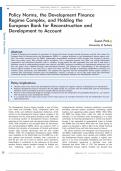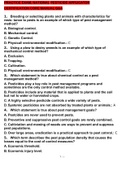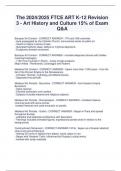Global Policy Volume 12 . Supplement 4 . May 2021
90
Policy Norms, the Development Finance
Regime Complex, and Holding the
European Bank for Reconstruction and
Development to Account
Special Issue Article
Susan Park
University of Sydney
Abstract
Created to facilitate the transition of economies of Central and Eastern Europe towards democracy and the free market, the
European Bank for Reconstruction and Development (EBRD) is a regional institution in the development finance regime com-
plex. This article examines how the EBRD’s independent accountability mechanism (IAM) emerged and changed to demon-
strate how policy norms filter through regime complexes. This is important because new ideas can change behavioural
expectations and institutional practices across a complex. Tracing where the idea originated from and how it took hold is
therefore central to understanding member state interests, the EBRD’s response considering its organisational preferences, and
how the policy norm solidified through inter-institutional learning. This deepens our understanding of the development
finance regime complex in two ways: first, it, shows how ideas can filter through to seemingly independent institutions via
member states, bureaucrats, and stakeholders. This supports the argument that the development finance regime complex is
coherent with increasingly consistent rules and obligations. Second, it reminds us not to reify states; while they demanded
institutional change nonstate actors influence what constitutes appropriate behaviour for development financiers.
Policy Implications
• Member states must ensure that development financiers mitigate the negative impacts of development on beneficiaries.
• Regional development finance institutions like the EBRD should be consistent with the World Bank and the International
Monetary Fund in providing recourse for people affected by their activities.
• Reviews of the institutional design of oversight mechanisms like the Independent Accountability Mechanisms, can improve
their consistency across development finance.
• It is essential that non-state actors be part of the review process of oversight mechanisms like the Independent Account-
ability Mechanisms.
The development finance regime complex is one of coher- entrepreneurial activities; fostering productive investment;
ence (Held and Schmidke, 2019), competition (Rana and providing technical project assistance; stimulating capital
Pardo, 2018), and inefficient duplication (Kellerman, 2018). markets; and supporting viable projects (EBRD, 1990). While
Central to the development finance regime complex is the the EBRD has largely flown under the radar of scholarly
World Bank and the International Monetary Fund (IMF), with attention, it is an institution worth investigating: it is a major
an increasing number of development finance institutions contributor to fostering development in Central and Eastern
operating at the regional and sub-regional levels (Kellerman, Europe; it has expanded its geographical scope to include
2018). Little analysed is the European Bank for Reconstruc- the Middle East and North Africa after the Arab Spring; its
tion and Development (EBRD), which was created in 1991 to capital was boosted in 2009 in light of the Global Financial
facilitate the transition of economies of Central and Eastern Crisis; and both China and India have joined as donors.
Europe (CEE) towards democracy and the free market This article examines the emergence and restructuring of
(Weber, 1994). The multilateral development banks (MDBs) the EBRD’s independent accountability mechanism (IAM), to
were modelled on the World Bank, but the EBRD has a dis- document how a policy norm spreads and solidifies within
tinct political and economic mandate, with a provision to the development finance regime complex. A regime com-
lend 60 per cent of its loans to private sector operations. plex is as ‘an array of partially overlapping and non-hierar-
Nevertheless, it contributes to the coherence of the devel- chical institutions governing a particular issue area’
opment finance regime complex through its fivefold mis- (Raustiala and Victor, 2004, p. 279). The literature on the
sion: mobilising capital to promote private and development finance regime complex has focused how
© 2020 University of Durham and John Wiley & Sons, Ltd. Global Policy (2021) 12:Suppl.4 doi: 10.1111/1758-5899.12881
, Policy Norms and the EBRD
91
states facilitate regime shifting for their own interests (Held IRM in 2003 to accord with its organisational preferences.
and Schmidke, 2019; Henning, 2019), with some arguing It promoted a highly technical, compliance oriented, over-
that ideas, networks, and endogenous feedback loops within sight mechanism under management control with minimal
the regime reinforce its coherence (Fioretos and Heldt, outlay, which made it difficult for project-affected people
2019). Supporting the latter argument, this article shows to access. The fourth section analyses how the policy norm
how states spread policy norms within the regime complex solidified over time through inter-institutional learning
and work with nonstate actors to solidify it. This is impor- where periodic reviews of the mechanism enabled non-
tant because new ideas can filter through regime com- state ‘Accountability Experts’ and non-government organi-
plexes, changing behavioural expectations and institutional sations (NGOs) to apply normative pressure to make the
practices. I use a constructivist analysis to examine how an IAM independent, solidifying the policy norm and creating
independent and relatively autonomous institution, the consistent rules and obligations across the development
EBRD, took up ideas about the importance of being held finance regime complex.
accountable to those they affect. This goes beyond simple
explanations of the EBRD reacting to member states’
Policy norms and the development finance regime
demands, which do not account for why donors demanded
complex
the policy norm’s establishment, nor how the EBRD chose to
implement and improve it. A policy norm is defined as Global governance is crowded with institutions that
‘shared expectations for all relevant actors within a commu- increasingly overlap as they seek to provide the means for
nity about what constitutes appropriate behaviour, which is states to cooperate and regulate the international system.
encapsulated in (Fund or Bank) policy’ (Park and Vetterlein, International regimes are complex ‘because of the coexis-
2010, p. 3). Tracing where the idea originated from and how tence of rule density and regime complexes’ (Alter and
it took hold is therefore central to understanding member Raustiala, 2018, p. 333).1 This has raised questions as to
state interests, the Bank’s response considering its organisa- how institutions interact, whether this creates institutional
tional preferences, and how the policy norm solidified competition, duplication, fragmentation, and ultimately,
through inter-institutional learning. This deepens our under- contributes to greater institutional effectiveness. Scholars
standing of the development finance regime complex in argue that the proliferation of institutions is being driven
two ways: first, it shows how ideas can filter through seem- in part by coalitions contesting multilateralism, or ‘when
ingly independent institutions via member states, bureau- states and/or nonstate actors either shift their focus from
crats, and stakeholders. This supports arguments that the one existing institution to another or create an alternative
development finance regime complex is coherent with multilateral institution to compete with existing ones’
increasingly consistent rules and obligations. Second, (Morse and Keohane, 2014, p. 387). Contested multilateral-
although states demanded institutional change and institu- ism is evidenced by regime shifting between institutions to
tions sought to circumscribe it, nonstate actors can influ- better enable actors to achieve their interests, for example
ence what constitutes appropriate behaviour for as states move between global and regional institutions in
development financiers. This qualitative research is based on response financial crises (Henning, 2019). It may also be
23 in-depth interviews with EBRD staff including former and evident through competitive regime creation or establish-
current accountability officers, former executive directors, as ing new institutions to challenge the status quo.
well as former US officials and environmental activists The rise of the Asian Infrastructure Investment Bank
between 2009 and 2017. This is backed by official EBRD (AIIB) and other development finance institutions driven by
publications and accountability mechanism annual and case rising powers have been viewed as competitive regime
reports. creation arguably because they were borne of discontent
The following section situates the EBRD within the devel- with Western dominated institutions (Wang, 2015), and
opment finance regime complex, and debates over the dri- challenged their dominance (Weaver, 2015). The new insti-
vers of regime complexity and institutional effectiveness. I tutions create competition that could encourage forum
argue that more research is needed to show how regime shopping (Henning, 2019), and fragmentation through
complexes become coherent. A constructivist analysis can inconsistent rules and obligations (Cooper et al., 2008). Yet
show how rules and obligations become more consistent the governance of the AIIB and New Development Bank
by tracing how policy norms spread and solidify, changing reveals complementarity with the World Bank and the IMF
behavioural expectations for the MDBs and their institu- (Held and Schmidke, 2019), and their operations demon-
tional practices. The second section examines how the strate that they are engaging in ‘healthy’ competition
EBRD’s donors took up the policy norm not in reaction to (Rana and Pardo, 2018). In other words, while there may
EBRD activities, but from the interests of the United States be competitive regime creation occurring, with some
that all the MDBs should have IAMs to provide recourse to degree of duplication, fears of fragmentation and ineffec-
people affected by the projects they finance. The US tiveness may be overstated.2
stance in the EBRD only makes sense if examined consider- In this article I investigate how the EBRD came to adopt
ing its engagement with stakeholders and other MDBs in rules and obligations consistent with other MDBs (Park,
the regime complex. The third section documents the 2017), as a means of demonstrating how coherence is pro-
EBRD’s implementation of the policy norm, creating the duced within the development finance regime. This
Global Policy (2021) 12:Suppl.4 © 2020 University of Durham and John Wiley & Sons, Ltd.







